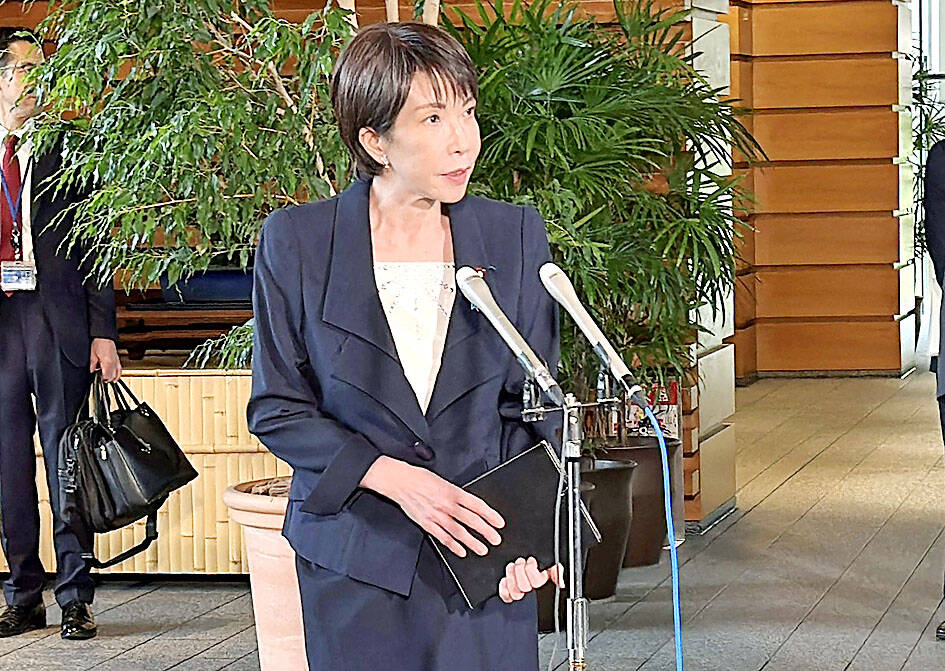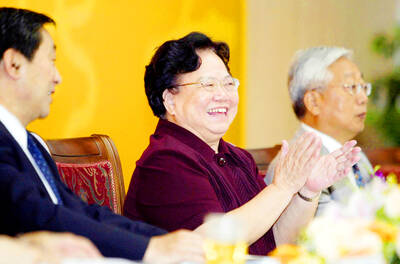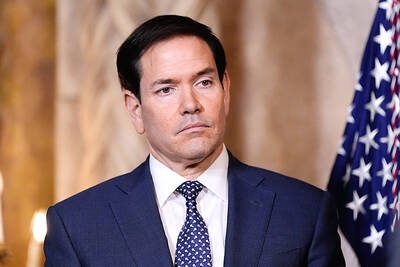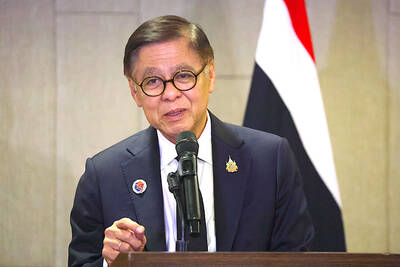Japan plans to show its determination to further build up its defense to rapidly adapt to changing warfare realities and growing tension in the region when US President Donald Trump visits Tokyo next week, Minister of Foreign Affairs Toshimitsu Motegi said.
Japanese Prime Minister Sanae Takaichi’s administration is also finalizing a purchase package, including US pickups, soybeans and gas, to present to Trump, but would not commit to any new defense spending target at the meeting, a source with knowledge of the preparations said.
The two leaders are to sit down in Tokyo on Monday and Tuesday next week during Trump’s first visit to Japan since his re-election last year, following an agreement by her predecessor, former Japanese prime minister Shigeru Ishiba, to invest as much as US$550 billion in the US in return for lower auto tariffs.

Photo: AFP
“The alliance with the United States is the cornerstone of Japan’s foreign and security policy,” Takaichi said on Tuesday at her inaugural news conference as prime minister.
“It would be premature to comment on any discussions during President Trump’s visit,” a Japanese government spokesperson said when asked about the planned purchase package and potential investments.
Motegi said that he hoped Trump’s first meeting with Takaichi would serve as an opportunity for the two leaders to discuss further strengthening the US-Japan alliance, while fostering their personal relationship of trust.
Japan also hopes to further cooperate with South Korea, along with other regional partners, including Australia and the Philippines, while seeking stable and constructive relations with China, he said.
Japan is undergoing a five-year military buildup through 2027 as part of its national security strategy, including doubling its annual defense spending to 2 percent of GDP. The strategy that promotes Japan’s strike-back capability with long-range missiles marks a major break from Japan’s defense-only principle under its postwar pacifist constitution.
Japan is expected to face tough demands from Trump to further increase its defense spending to NATO levels of 5 percent of GDP, more purchases of costly US arsenals and additional spending for 50,000 US troops in Japan under the bilateral security pact.
“Our national defense should be based on our own independent decision,” Motegi said. “What’s important is not the amount or the GDP ratio, but what’s in it.”
Meanwhile, the sweeteners Takaichi plans to offer Trump in her first major diplomatic test include the purchase of Ford F-150 pickup trucks, an idea floated by Trump, and an agreement to buy more US soybeans, which US Secretary of Commerce Howard Lutnick requested in a call with his Japanese counterpart last week, said two sources, who asked not to be identified because they are not authorized to talk to the media.
Beijing curbs of US soybean imports have hurt US farmers reliant on Asian markets. Last month, exports to China dropped to zero for the first time in almost seven years.
The F-150s, designed for wider US roads, might be used in Japan as snow plows.
Trump is also to meet Japanese Emperor Naruhito. The US leader and Takaichi are expected to travel to Malaysia for an ASEAN gathering from Sunday next week, and later to South Korea, which is hosting an APEC summit.

The death of a former head of China’s one-child policy has been met not by tributes, but by castigation of the abandoned policy on social media this week. State media praised Peng Peiyun (彭珮雲), former head of China’s National Family Planning Commission from 1988 to 1998, as “an outstanding leader” in her work related to women and children. The reaction on Chinese social media to Peng’s death in Beijing on Sunday, just shy of her 96th birthday, was less positive. “Those children who were lost, naked, are waiting for you over there” in the afterlife, one person posted on China’s Sina Weibo platform. China’s

‘POLITICAL LOYALTY’: The move breaks with decades of precedent among US administrations, which have tended to leave career ambassadors in their posts US President Donald Trump’s administration has ordered dozens of US ambassadors to step down, people familiar with the matter said, a precedent-breaking recall that would leave embassies abroad without US Senate-confirmed leadership. The envoys, career diplomats who were almost all named to their jobs under former US president Joe Biden, were told over the phone in the past few days they needed to depart in the next few weeks, the people said. They would not be fired, but finding new roles would be a challenge given that many are far along in their careers and opportunities for senior diplomats can

Australian Prime Minister Anthony Albanese yesterday announced plans for a national bravery award to recognize civilians and first responders who confronted “the worst of evil” during an anti-Semitic terror attack that left 15 dead and has cast a heavy shadow over the nation’s holiday season. Albanese said he plans to establish a special honors system for those who placed themselves in harm’s way to help during the attack on a beachside Hanukkah celebration, like Ahmed al-Ahmed, a Syrian-Australian Muslim who disarmed one of the assailants before being wounded himself. Sajid Akram, who was killed by police during the Dec. 14 attack, and

RUSHED: The US pushed for the October deal to be ready for a ceremony with Trump, but sometimes it takes time to create an agreement that can hold, a Thai official said Defense officials from Thailand and Cambodia are to meet tomorrow to discuss the possibility of resuming a ceasefire between the two countries, Thailand’s top diplomat said yesterday, as border fighting entered a third week. A ceasefire agreement in October was rushed to ensure it could be witnessed by US President Donald Trump and lacked sufficient details to ensure the deal to end the armed conflict would hold, Thai Minister of Foreign Affairs Sihasak Phuangketkeow said after an ASEAN foreign ministers’ meeting in Kuala Lumpur. The two countries agreed to hold talks using their General Border Committee, an established bilateral mechanism, with Thailand